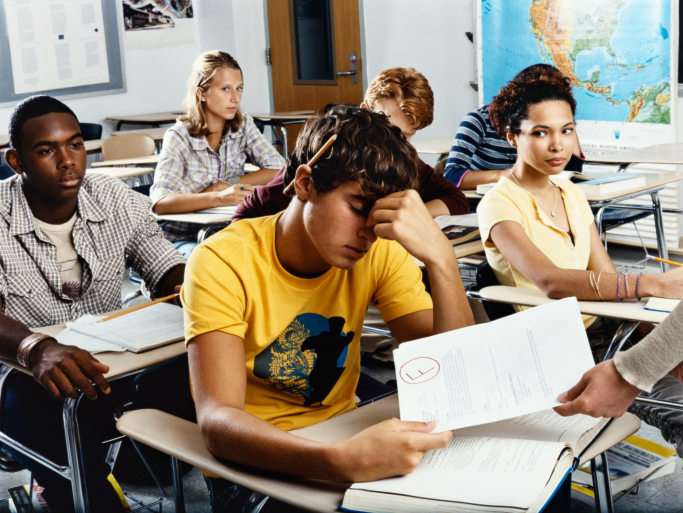All American children are guaranteed a free public education, but nobody pretends that education is “equal.” The quality of public schools varies widely, and education experts have struggled for decades to correct the inequities—seemingly with little success. But a recently released study suggests that the solution could be surprisingly straightforward.
The study—by associate professor Rucker C. Johnson at UC Berkeley’s Goldman School of Public Policy and professors C. Kirkabo Jackson and Claudia Persico of Northwestern University—examines the relationship between money and educational outcomes.
According to their findings, increasing per-pupil spending is an extremely effective way to shrink the learning gap between poor and rich kids:
“The estimated effect of a 22 percent increase in per-pupil spending throughout all 12 school-age years for low-income children is large enough to eliminate the education gap between children from low-income and nonpoor families.”
That 22 percent increase translates into spending about $2,863 more per student each year (per-pupil spending levels differ wildly in each state) and it would have to apply every year from kindergarten through 12th grade.
“The effect of a 22 percent increase in per-pupil spending throughout all 12 school-age years for low-income children is large enough to eliminate the education gap.”
It’s a whopping price tag, but one that could potentially level the playing field for students in public schools—and later, among adults in the workforce. “The longer you’re exposed to these increases in spending, the larger the impact is on your subsequent educational and economic outcome,” says Johnson.
This might seem like a no-brainer, but it actually runs counters to the conventional wisdom of the past 50 years. In 1966, sociologist James Coleman conducted a large-scale study to assess the effects of school spending on education outcomes. Coleman—who relied mostly on data from standardized tests—concluded that the amount of money spent on a student had no significant bearing on their academic achievement.
Coleman’s study was enormously influential in the field of education. But Johnson contends that it has led many researchers to focus too narrowly on short-term educational outcomes, such as test scores and grades.
“Our view is that provides a limited scope for assessing the effectiveness of increases in school spending,” Johnson says. “So we have a much longer frame: We follow cohorts into adulthood.”
Yes, Johnson, Jackson and Persico spent several years collecting data from more than 15,000 individuals who were born between the years 1955 and 1985. Instead of test scores, the team looked at information that would reflect how education affected an individual’s long-term outcomes: educational debt, employment history, marital status, and so forth.
To measure the actual relationship between money and student outcomes, the team looked at school finance reforms—changes instituted in the 1970s after courts orders in dozens of states increased funding for chronically impoverished school districts. Before these reforms, school districts drew most of their funding from local property taxes. As a result, school districts typically reflected the wealth of their neighborhoods: Schools in Beverly Hills had (and have) far more resources to draw on than schools in Watts.
According to Johnson and his colleagues, these school finance reforms had a strong positive effect on students from low-income school districts. Just a 10 percent increase in spending on a student for each year of their public education—12 years total—resulted in them completing, on average, an extra half-year of education. As grownups, these students had wages that were nearly 10 percent higher than their peers, and fewer of them experienced adult poverty.
“From a research standpoint, you need to isolate school spending changes that are completely unrelated to demographic changes in the schools,” Johnson says. He also noted that these court rulings were ideal external factors for measuring the effects of spending changes on student performance.

But a split remains among education experts between those who believe more school spending leads to better outcomes, and those who don’t.
Stanford professor Eric Hanushek has been the most vocal critic of Johnson’s study. Hanushek insists that fixing an educational system isn’t like fixing a car—throwing more money at it won’t make the problem go away.
“Most people who are used to going out and shopping for cars realize that if they spend more on a car, they tend to get ones that are better,” Hanushek says. “So it’s intuitive that spending more on schools would allow us to improve [them]. The problem is the historical evidence doesn’t support that.”
The historical evidence Hanushek cites is the decades-long timeline of spending increases on students in the United States. From 1970 to 2010, there was a roughly 150 percent increase in real spending per pupil for students across the country.

UC Berkeley education professor Bruce Fuller, director of the Policy Analysis for California Education research center based at Stanford and Berkeley, examined the study and Hanushek’s critiques published on Education Next. Fuller says he couldn’t find any data flaws in Johnson, Jackson and Persico’s methodology. Fuller also observed that school finance reforms may not have closed the attainment gap, but that they did improve the outcomes for students in the poorest school districts—a fact Hanushek seemed to downplay in his own analysis.
“[The results] pertain to spending as a result of court action, which tends to focus on equalizing per-pupil spending, which does in fact help low-income kids, but it doesn’t necessarily boost the fortunes of middle classes,” Fuller says. “None of these court cases were ordering general increases in spending across all social classes and neighborhoods.”
Fuller adds that Hanushek did identify a significant shortcoming in the study’s conclusion, which is that it doesn’t adequately explain how extra money should be spent in schools.
“Rick is making a good point, which is the paper arrives at the same question it arrived at 35 years ago, which is how do we make money matter in schools,” Fuller says. “I think the only weakness of the design in the paper is we can’t really identify the mechanisms through which the gains were achieved for young people.”
Johnson agrees that it’s difficult to pinpoint a precise answer to this question. Based on his research into school finance reforms, he said that there seem to be three general areas where increased funding can make the biggest difference in a student’s long-term outcomes: reducing class size, boosting teacher salaries, and lengthening the school year.
For his part, Hanushek argues that money should be used to retain top-notch teachers. He cited a study he conducted years ago in Gary, Indiana, which demonstrated that children under good teachers could pick up one-and-a-half years in learning gains over the course of a regular school year. On the other hand, students under the worst teachers sometimes ended up with only half a year’s worth of learning gains after an entire school year.
Researchers on both sides acknowledge that solving all the inequities in education will take more than just reforming schools.
“There’s a tendency for us to talk about educational policy in a vacuum,” says Johnson, “with health policy in another container, and economic housing policy in a whole different container, as if they’re not inextricably connected and aren’t all affecting children’s life outcomes.”





















